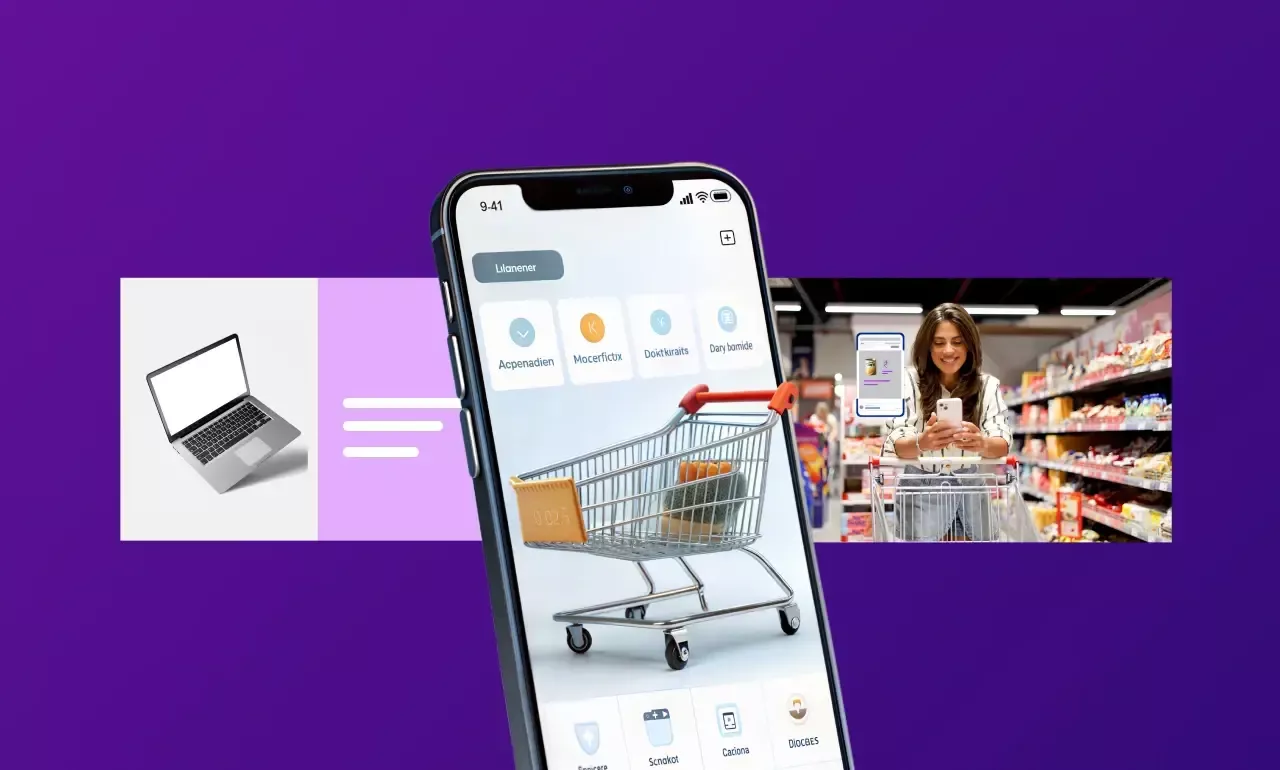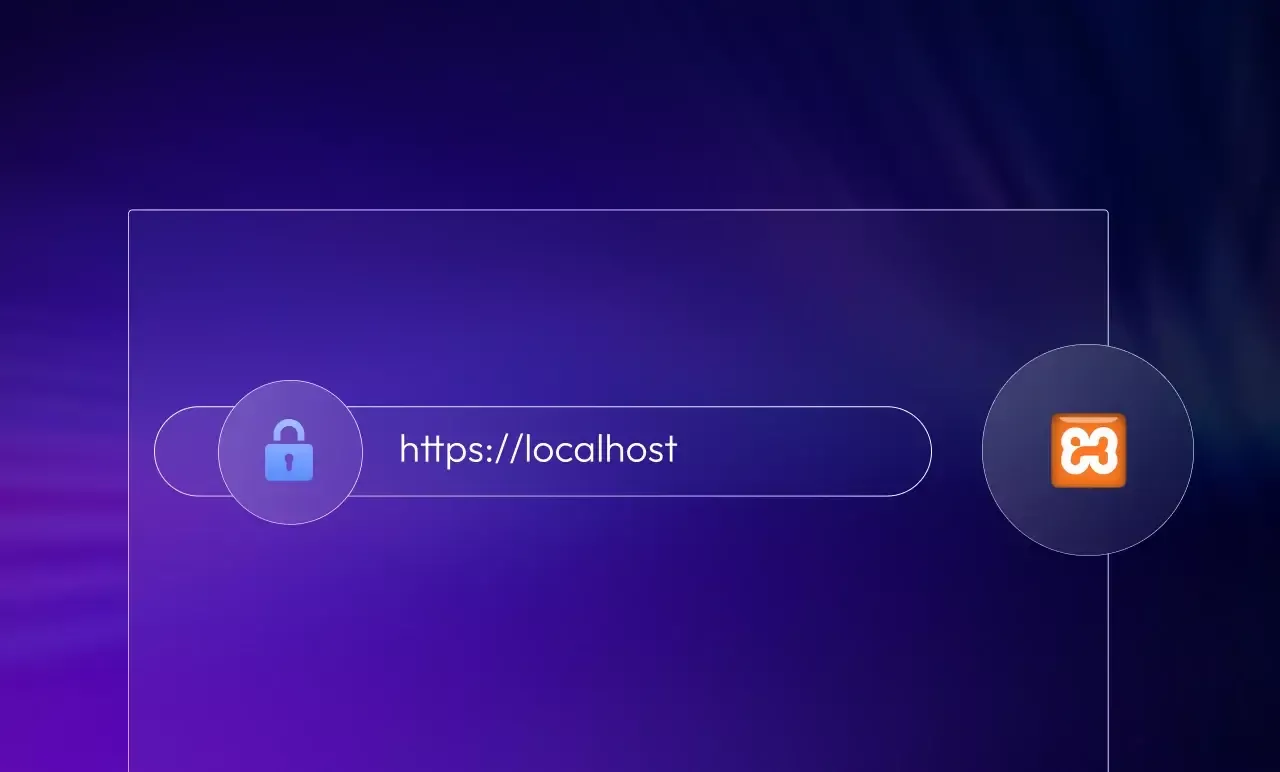The Power of Data Visualization Using Tableau
Sales-Driven Ecommerce Content Strategy: How to Boost Conversions and Revenue
Ecommerce is about selling products, but having an ecommerce content strategy is about building connections, building trust, and guiding customers through their buying journey.
In a crowded digital marketplace, simply showcasing products won’t cut it. To stand out, brands need to engage, educate, and inspire their audience at every touchpoint.
Compelling content acts as the bridge between your brand and your customers, transforming your business from a mere retailer into a trusted authority.
A well-crafted content strategy for ecommerce doesn’t just grab attention; it turns casual browsers into repeat customers.
So, if your content isn’t moving people to action, it’s time to rethink your strategy.
Here’s why fine-tuning your ecommerce content marketing strategy is crucial.
Understanding the Importance of eCommerce Content Strategy
If you are wondering, “What is an ecommerce content strategy?” and why it is important, know that quality content fuels every step of the buyer’s journey.
From attracting new visitors to turning them into loyal customers, without a solid content strategy, your brand risks getting lost in a sea of competitors.
Here’s how:
Boosts SEO & Increases Visibility
If your content isn’t optimized for search engines, potential customers won’t find you. A strategic mix of blogs, product guides, and SEO-driven pages helps your store rank higher on Google and social media searches.
- Stronger organic search presence
- Increased brand discovery on social media
- More qualified leads landing on your site
Builds Brand Awareness & Differentiation
The e-commerce space is crowded, and content helps you stand out. A well-crafted strategy positions your brand as an authority. Whether through social media campaigns, blog content, or email marketing, the right messaging ensures your brand remains memorable and trustworthy.
Ways to build awareness include:
- Unique storytelling that sets your brand apart
- Engaging content on multiple platforms (blogs, social media, videos)
- Promotions that attract and retain customers
Nurtures the Buyer's Journey
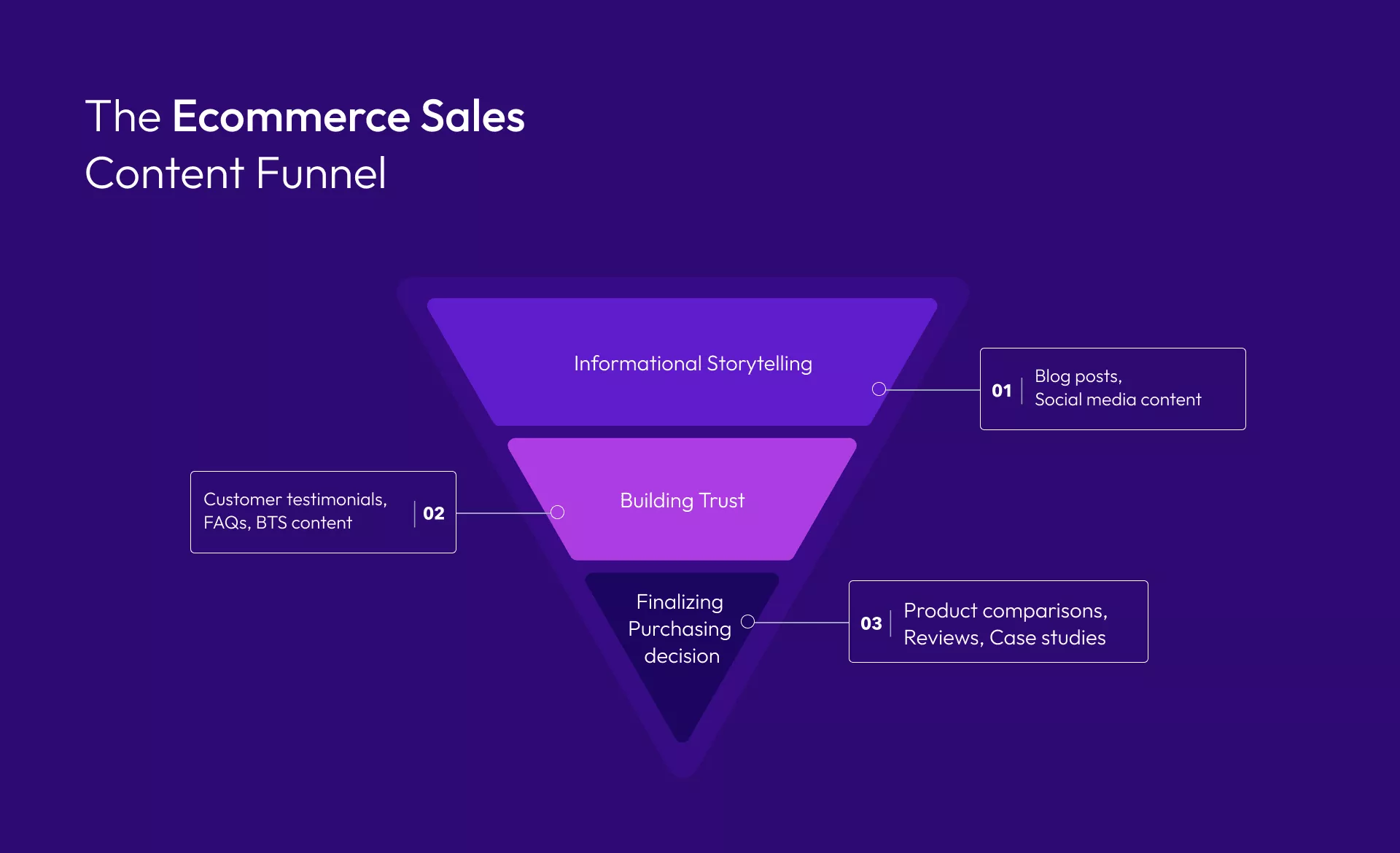
Not every visitor is ready to buy immediately. A well-structured content funnel guides them from awareness to conversion by addressing their needs at every stage:
- Top-Funnel: Blog posts, social media content, and storytelling introduce your brand.
- Mid-Funnel: Customer testimonials, FAQs, and behind-the-scenes content build trust.
- Bottom-Funnel: Product comparisons, reviews, and case studies help finalize the purchase decision.
By offering value at every stage, you turn passive browsers into active buyers.
Educates and Builds Trust
People don’t buy from brands they don’t trust. By creating valuable, informative content, you position yourself as an industry expert while answering customer questions before they even ask.
Whether through detailed product comparisons, how-to guides, or customer testimonials, the right content reduces doubt and builds confidence in your brand.
Strengthens Customer Loyalty & Retention
Acquiring a new customer is great, but keeping them engaged is even better.
Strategies like personalized emails, loyalty programs, and educational content create ongoing interactions, fostering a community around your brand.
An excellent ecommerce content strategy example comprises brands with engaging loyalty programs. They encourage users to interact beyond just making purchases, resulting in increased customer retention.
Powers Conversions & Revenue Growth
By creating targeted, persuasive content that meets user intent, you can optimize every touchpoint in the sales funnel to increase conversion rates and boost revenue.
Steps to Build the Best Ecommerce Content Strategy
If you’re not sure where to begin, here is a step-by-step blueprint to create a compelling content strategy for e-commerce.
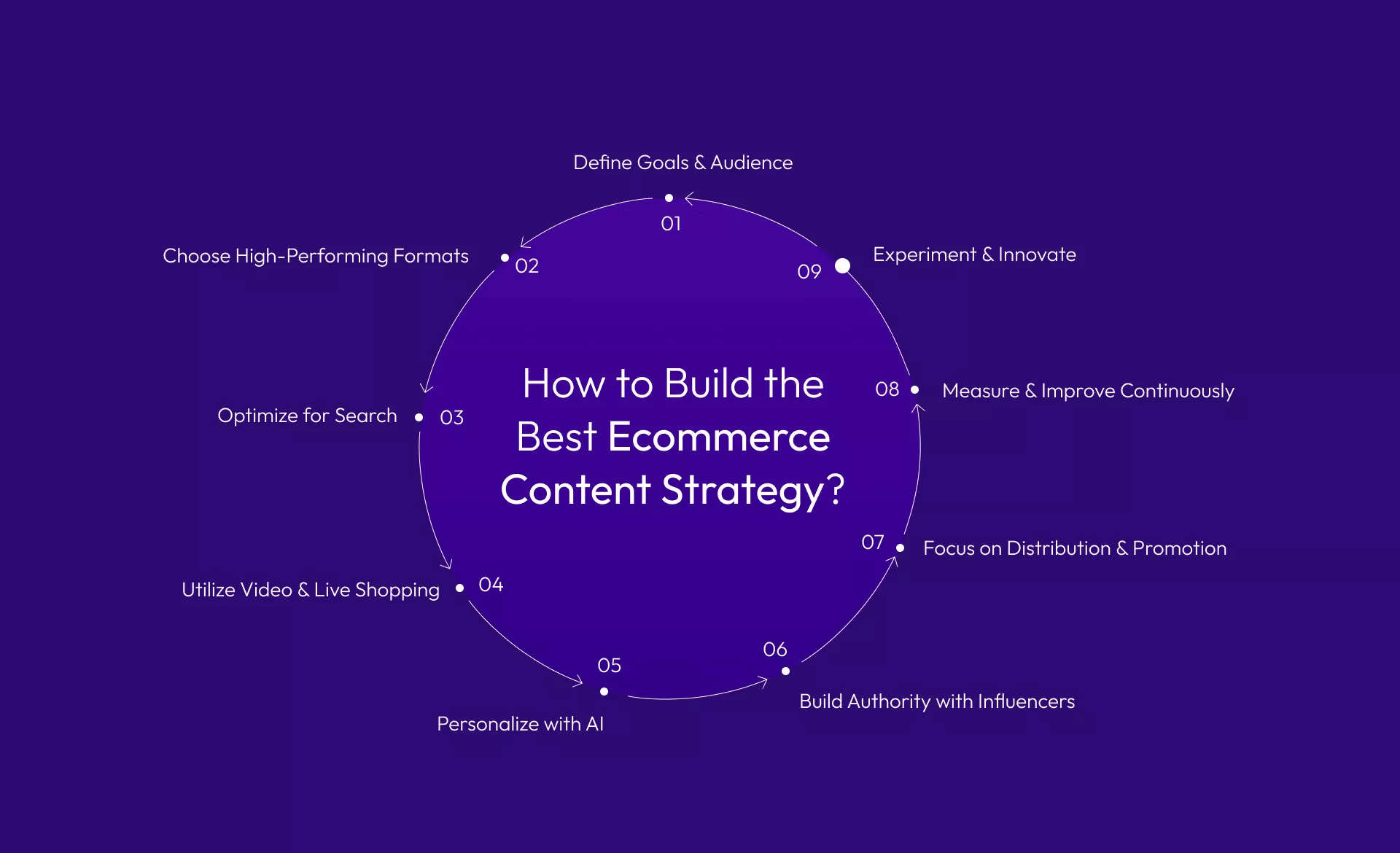
Step 1: Define Your Content Goals & Audience
Before diving into content creation, it’s essential to clarify your goals.
Ask yourself key questions like:
Are you looking to increase brand awareness, boost conversions, or build long-term customer loyalty?
Understanding your primary objectives will help shape a focused and intentional strategy that directly addresses your business needs.
Also, identify your target audience's demographics, interests, and behaviors to create highly relevant and engaging material.
Step 2: Choose High-Performing Content Formats
Not all content types deliver the same results, so it's crucial to choose formats that best capture your audience’s attention and drive engagement.
Start by identifying content types that align with your goals.
You can do so by knowing which one to focus on from the following categories.
- Awareness Content: Create buyer guides and how-to content. Include infographics, carousels, lookbooks, etc. Such interactive and educational content helps customers make informed decisions, increasing trust and the likelihood of conversion.
- Sales-Centric Content: Focus on driving conversions with product-focused content. Utilize video content like tutorials and demos to highlight how your product solves customer pain points. Share success stories and provide helpful resources like tutorials and FAQs. Also, encouraging customers to share their experiences and leverage user-generated content (UGC) to make your brand feel more relatable and trustworthy.
- Thought Leadership Content: Establish credibility by sharing industry insights, predictions, and expert opinions. Partner with influencers to reach new audiences and build credibility. This can amplify your message and extend your reach by introducing your brand to their established, loyal followers.
Step 3: Optimize for Search & Discoverability
Search engine optimization (SEO) is the backbone of any successful ecommerce content strategy. It helps search engines understand your content, improving your rankings and visibility.
To start:
- Conduct thorough keyword research to find high-intent search queries. Then, build content around those to make sure it meets the specific needs of people actively searching for solutions.
- Optimize product descriptions, meta tags, and URLs with target keywords. This forms the basis of any successful ecommerce content marketing.
- Build internal links to help visitors discover more of your content and drive them toward conversion points like product pages or checkout.
- Optimize alt-text for images to ensure that they are indexed by search engines and help increase overall visibility.
- Regularly monitor your SEO metrics to see how your efforts are performing and adjust content or strategies for better results.
Step 4: Use the Power of Video & Live Shopping
Video content is one of the most engaging ways to connect with your audience. With platforms like TikTok and Instagram evolving into search engines, prioritizing video content is no longer optional. Ecommerce businesses must make it a key part of their marketing strategy to stay ahead of the competition.
Here’s how video content can benefit your business:
Immersive experience: Whether it’s tutorials, product demos, or customer success stories, video helps convey key information quickly and effectively.
Real-time engagement and sales: Live shopping allows real-time interaction with customers, building excitement and urgency over exclusive deals that can lead to impulse purchases.
Humanizing brands: Sharing behind-the-scenes footage or stories gives your brand a more personal, relatable feel, fostering trust and loyalty among your audience.
Step 5: Personalize with AI
Modern ecommerce is all about delivering the right content to the right customer at the right time. AI-driven personalization ensures that your audience sees content tailored to their interests, behaviors, and past interactions, boosting engagement and conversions.
Here’s how AI transforms content personalization:
- AI-powered Product Recommendations: Suggest products based on browsing history, past purchases, and user preferences.
- Dynamic Content Personalization: Adapt website banners, email campaigns, and product pages in real time for different customer segments.
- Automated Chatbots & Virtual Assistants: Provide personalized shopping assistance and answer queries instantly.
- Predictive Analytics: Analyze customer behavior to anticipate future preferences and refine marketing strategies.
By leveraging AI and machine learning, ecommerce brands can create a more engaging, intuitive, and conversion-focused shopping experience. Personalized content doesn’t just improve user satisfaction—it also builds long-term customer loyalty and drives higher revenue.
Step 6: Build Authority with Influencers & Experts
Influencer marketing provides a unique opportunity to amplify your message and tap into new audiences.
Influencers can review products, offer demonstrations, or simply share their personal experiences with your brand. This type of content is often more engaging and relatable than traditional advertisements.
Building a network of influencers and industry experts helps establish your brand’s credibility and reach wider, untapped markets.
To make the most of influencer partnerships, be sure to track performance metrics such as engagement rates, referral traffic, and conversions so you can continually optimize your strategy.
Step 7: Prioritize Content Distribution & Promotion
Creating stellar content is only half the battle. Getting it in front of the right audience is where the magic happens.
An effective content distribution strategy involves leveraging a mix of the following practices:
- SEO-optimized organic traffic, email marketing for engagement, and paid ads for immediate results
- Content promotion on the right platforms where your audience is most active.
- Partnerships and referral programs to extend reach and attract new customers through trusted sources.
Step 8: Measure & Optimize for Continuous Improvement
To ensure your content strategy is delivering the results you need, it’s essential to keep an eye on the following:
- Monitor KPIs such as traffic, bounce rates, and conversions to gauge content effectiveness.
- Focus on conversion rates to track how content leads to desired actions (purchases, sign-ups).
- Analyze customer retention data (repeat purchases, customer lifetime value) for long-term insights.
- Regularly review content performance to make data-driven improvements.
Step 9: Experiment, Adapt & Innovate
The market and customer preferences are constantly evolving, and so should your content strategy.
It’s important to continuously test new ecommerce content ideas, formats, and distribution methods to keep your audience engaged and stay ahead of the competition.
Customer feedback also plays a crucial role in shaping your content strategy. Encourage your audience to provide input through surveys, reviews, and social media comments. Take their feedback into account and use it to refine your approach, ensuring your content remains relevant and resonates with your audience.
Common Mistakes to Avoid in Ecommerce Content Strategy
While we are at it, let’s also have a look at some common mistakes that must be avoided.
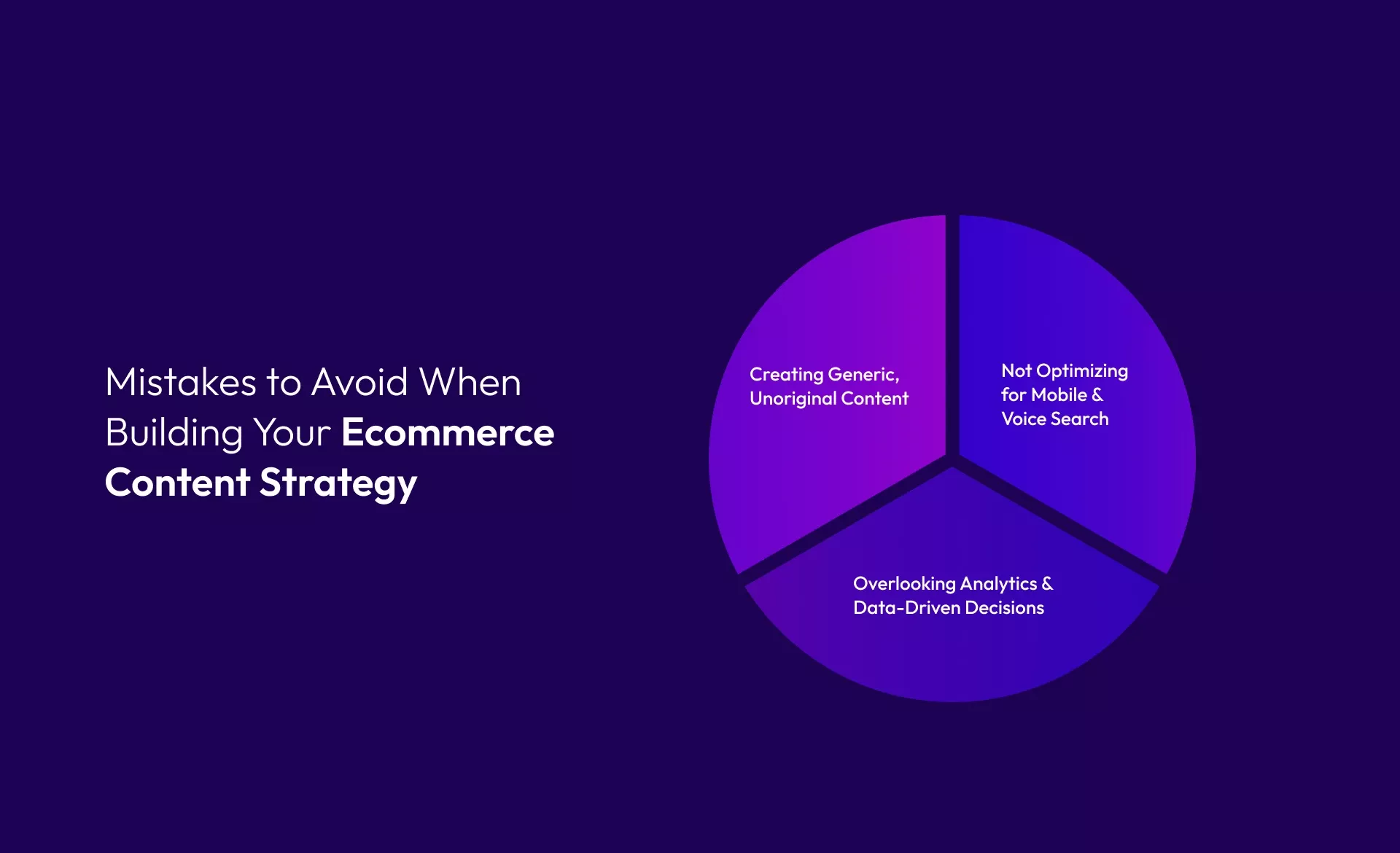
Creating Generic, Unoriginal Content
Bland, recycled content won’t capture attention or build brand credibility.
- Offer unique insights instead of repeating industry clichés.
- Use storytelling and high-quality visuals for better engagement.
Not Optimizing for Mobile & Voice Search
With mobile and voice search on the rise, ignoring them limits reach.
- Ensure mobile-friendly design and fast loading times.
- Use conversational keywords and FAQs for voice search optimization.
Overlooking Analytics & Data-Driven Decisions
Without tracking performance, you can’t refine your strategy.
- Monitor traffic, engagement, and conversion rates.
- Use analytics tools to optimize content based on real insights.
Avoiding these mistakes keeps your ecommerce content strategy effective, engaging, and competitive.
Turn Your Content into a Growth Engine
In eCommerce, content is the foundation of customer trust, engagement, and long-term success. A well-executed ecommerce content strategy attracts, informs, and converts, turning casual visitors into loyal customers.
From SEO-driven blog posts to high-impact social media campaigns, every piece of content should have a clear purpose: to connect with your audience and reinforce your brand’s value.
It all starts with a well-rounded marketing approach.
Don’t know how to begin?
Explore how Sundew’s Marketing and Strategy services integrate content marketing to drive engagement and improve conversions.
Let’s turn your content into a powerful engine for growth!
Email us or Talk to us at +91-98367-81929 or Simply Contact Us through the website.
Let's Connect




